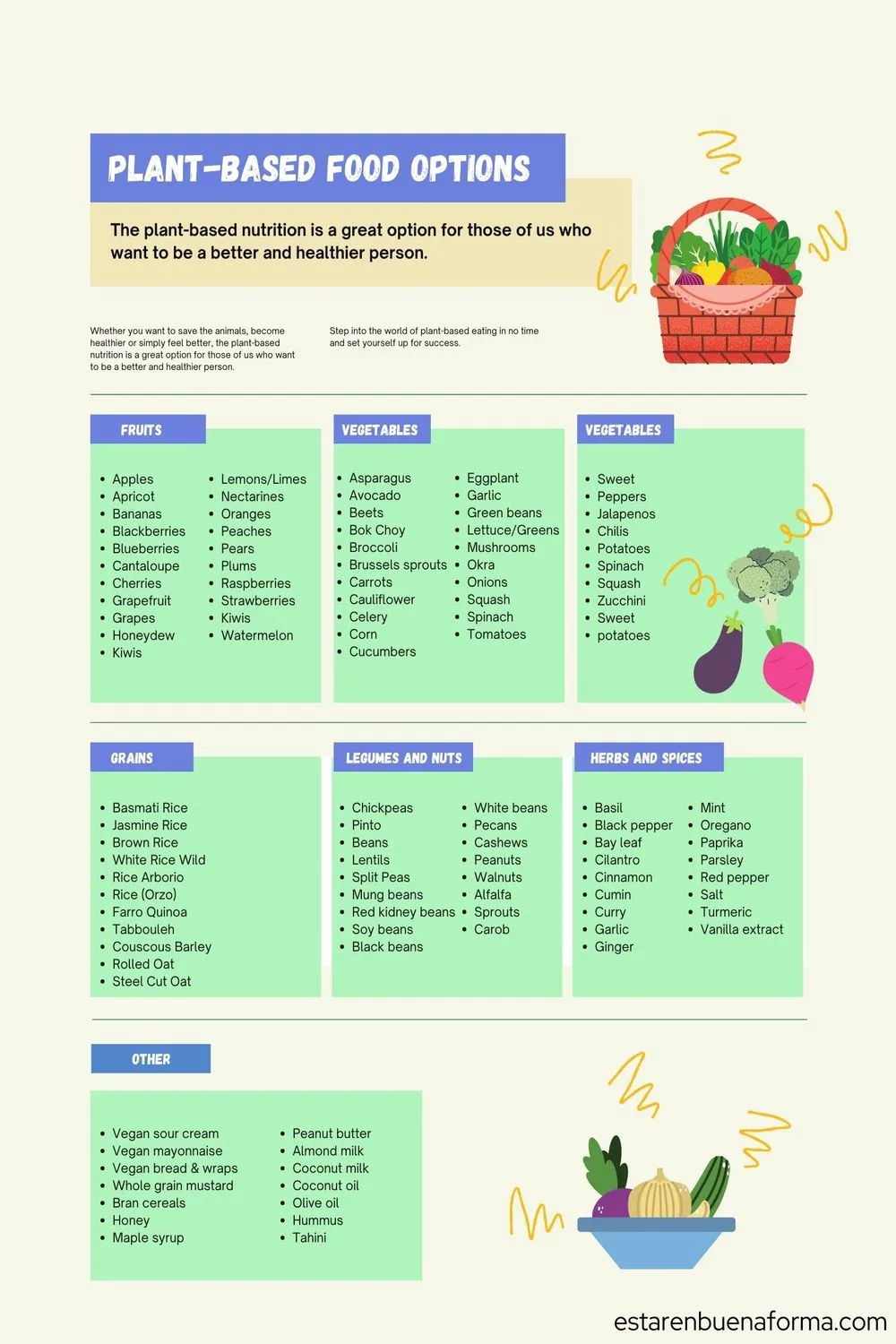What we eat has a mayor impact on our health. That’s why the plant based lifestyle movement in growing. And more people are now embracing a healthier approach when it comes about eating.
So you are going to learn the benefits of adopting this approach, and why/how to choose a plant based lifestyle that suit your needs.
Plant-based lifestyle
To successfully adopt a plant-based lifestyle, small steps should be taken. That way you can have the opportunity to adopt and maintain new habits. Slow and steady is a great strategy to form new habits.
We are hearing the phrase plant-based lifestyle movement more and more in our society. With the launch of documentaries like Game Changers, books like Forks over Knives, and the emergence of athletes changing their nutrition to be plant-based, one has to wonder what this is all about.
In the world of nutrition, plant-based eating is having a large portion of one’s nutrition coming from vegetables, fruits, herbs, nuts, whole grains, and legumes or other plants.
Plant-based nutrition
A spectrum of plant-based nutrition options is available to you. Some are very strict (vegan diet). Others are still adding animal products like dairy (vegetarian). At the other end of the spectrum are those who still eat meat, poultry, and fish on an occasional basis.
We once believed that early humans consumed a large proportion of animal protein in their diet. It is from that belief that, in the 2000s, the Paleo diet (mainly comprised of animal protein) became really popular in the world of nutrition and diet.
Although, we now know that the nutrition of bipedal primates and Homo sapiens was primarily composed of nuts, fruits, leaves, roots, seeds and water. In that case, the “original” Paleo Diet was in reality plant-based eating.
It is also linked to the fact that some of the strongest animals on Earth are not carnivores. The strongest mammal is the gorilla (most are herbivores). It can lift around 4409 lbs., which is 10 times its body weight.
It would be like a 200 lb. individual lifting 2000 lb. If other mammals can live a healthy and strong life on plant-based nutrition, we probably can too.
Why choose plant-based nutrition?
Many reasons exist for choosing plant-based nutrition. We will discuss in more details some of those reasons and the great benefits. Here’s our top 5:
Improve your health
Most Americans consume double the recommended daily intake of protein which can also cause issues with digestion. By reducing your intake of animal food, you will most likely reach the recommended daily intake of protein without surpassing it.
In addition, an increased consumption of vegetables, grains, and beans will bring more fiber into your nutrition. Most Americans don’t consume enough fiber and that can lead to inflammation of the digestive tract, constipation, and hemorrhoids.
Succeed in weight loss and weight management
In general, individuals who are on plant-based nutrition tend to consume fewer calories than individuals who consume animal protein. That is because most of their calories are coming from healthier options and fewer calories per weight.
Plant-based eaters tend to eat less processed food and avoid meat-focused restaurants like fast-food chains that provide unhealthy meal options.
Prevent or manage a chronic disease
Research demonstrates that individuals on plant-based nutrition can prevent chronic disease, reduce obesity and mostly encourage a healthy lifestyle and increase their quality of life.
Stop spending on supplements
Did you know that our nation’s population spends more than $30 billion a year on supplements?
What if you didn’t need to waste that money? With plant-based nutrition, you are more likely to receive all the nutrients you need from natural sources like legumes, vegetables, and fruits. Not only does this save you money, but it also saves you from trying to remember to purchase and consume supplements.
Save our planet
Agriculture uses approximately 70% of our freshwater (globally on average). That said, the production of meat requires around 1000% more water (1 kg requires from 5000 to 20,000 liters of water) than some grains like wheat (1 kg of wheat requires between 500 and 4000 liters of water).
In addition, a lot of the grain is cultivated to feed the animals we eat and if we started eating that grain and reduced our consumption of meat, less water, and fewer resources would be used to produce animal food.
Types of plant-based diets
As mentioned earlier, a spectrum of plant-based eating is available to you. Start by identifying what you would like to change in your nutrition. Considering that your nutrition will be mainly coming from plants, your options are:
Strict plant-based nutrition (vegan)
With strict plant-based nutrition, you are not going to consume any meat, fish, or animal products like dairy foods, honey or eggs.
Vegetarian plant-based nutrition
In vegetarian plant-based nutrition, you will be able to consume eggs, milk, cheese, and other products of animals but no meat or fish.
Pescatarian plant-based nutrition
The pescatarian plant-based nutrition is similar to the vegetarian one but includes fish. That would mean that your nutrition includes plant-based food, eggs, milk, cheese, fish, and other products of animals but no meat.
Flexitarian plant-based nutrition
This option is great for individuals who would like to slowly move into plant-based eating without fully committing to never eat meat again. In this plant-based nutrition option, your meals will have a large proportion of plant-based food.
In addition to small portions of eggs, or dairy foods and, on occasion, include meat, fish, seafood or poultry. Some individuals in that category have adopted the meatless Mondays to reduce their consumption of animal protein.
Is it hard for you to decide?
If so, let me ask you this question. On a scale of 1 (not ready) to 10 (let’s do this), how ready are you to make a change in your nutrition?
If you said 1–5, try option 4. But if you said 6–10, try option 2 and see if you can stick to it. Maybe give yourself a month to ease into your new change.
For example, stop purchasing meat products when you go to the grocery, and finish eating all the animal food in your fridge and freezer. We wouldn’t want to cause food waste, especially if you are choosing plant-based eating because of environmental benefits.
Adapt Your Grocery
In order to ease yourself into plant-based eating, try to slowly increase the amount of plant-based food on your grocery list and stop purchasing animal protein and dairy products.
Stock up on cans of legumes such as black beans or chickpeas since they are fast and easy ingredients to add to many recipes (just make sure they are not full of sugar or salt).
When purchasing vegetables in cans instead of selecting fresh ones, make sure to read the label and avoid added sugar or salt. You can pick a no- or low-sodium option.
In addition, you can also select frozen vegetables like peas or corn, the same warning applies. Make sure to read the label, some frozen food has added sugar, salt, and butter.
You can start by taking a look at the labels on the products that you have in your pantry and freezer. This might require a bit more shopping time at first but eventually, you will know which brand is the healthiest.
Here are some examples of items that could be on your plant-based grocery list:

Plan your meals
One of the most difficult parts about adapting to plant-based eating is to adopt new habits in the kitchen. Instead of having burgers or roasted chicken for dinner, you have to find new ways to cook and bring more plant-based food to your table.
If you are going to try the vegan approach, breakfast might be the most difficult to adapt, especially if you are used to eating eggs in the morning.
It is strongly recommended to try new recipes as opposed to try to adapt your old recipes to plant-based nutrition. For example, a plant-based Mac and Cheese is hard to make.
In the regular dish, cheese is the main ingredient and plant-based cheese is far from having the same taste and texture.
Here are a few ideas of meals you can plan for each meal. If you are going for strict plant-based nutrition, make sure to select items that are vegan-friendly for the bread, wraps, mayonnaise, and other condiments.
Breakfast
Breakfast can be difficult when you are used to a bacon and egg type of breakfast. Try to keep fruits, bran cereal oats, and vegan bread in the house, that way, you will have quick options when you don’t want to think too much about what to make. Here are some breakfast ideas:
- Bran cereals with bananas and plant-based milk (this will be a winner for your fiber intake).
- Oatmeal in a jar
- Vegan bread with natural peanut butter and no-sugar-added jam
- Fruit salad
- Hummus and pita bread
Lunch
If your usual lunch is deli meat sandwiches, you will be going through a bit of a transition for meal planning. In general, many plant-based options can be quick and made in advance (i.e. salad in a jar).
Dinner
In general, dinner is the time when individuals spend more time with friends or families. A plant-based dinner can be a combination of vegetables, grains, and legumes. Here are a few examples:
- Veggie Burger with sweet potato fries
- Vegetable, black beans, and rice stir fry
- Rice and beans with plantains
- Grain bowls
- Risotto with roasted vegetables
Take it one step at a time
The best way to start plant-based eating is to start with small steps now. Choose a day this week when you want to have a plant-based nutrition day. That day will be the beginning of your journey in plant-based eating. Once you’ve chosen a date, pick your recipes!
And most importantly enjoy it. As stated, this is a plant-based lifestyle movement that more and more people are harnessing.

David es escritor y profesor graduado. Escribe para diferentes sitios web. Con más de 7 años de experiencia en escritura y educación, David ha combinado su experiencia en la enseñanza con su pasión por el bienestar físico y mental. Investiga y escribe para brindarle información valiosa sobre pérdida de peso, nutrición, fitness, comunidad, sociedad y más.




